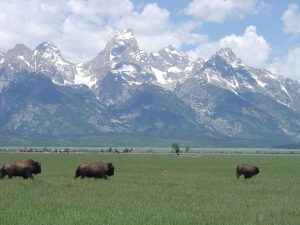Chapter 1 Introduction to Geoscience
What is Geology?
In its broadest and modern sense, geology is the study of Earth and Earth Systems—it is not just the study of rocks and minerals. It is the study of the interactions and feedbacks between the Earth’s sub-systems’ cycles, processes, and “spheres” (the exosphere, the atmosphere, the hydrosphere, and the solid Earth). From a practical stand point, it is the study of a its interior and its exterior surface, the minerals, rocks and other materials that are around us, the processes that have resulted in the formation of those materials, the water that flows over the surface, through the ground, and cycles through the atmosphere, the study of biological-geological interactions, the changes that have taken place over the vastness of geological time, and the changes that we can anticipate will take place in the near future. It is arguably the most integrated of all of the sciences because it involves the understanding and application of all of the other sciences: physics, chemistry, biology, mathematics, astronomy, and others. But unlike most of the other sciences, geology has an extra dimension, that of time—deep time—4.56 billion of years of it. Geologists study the evidence that they see around them, but in most cases, they are observing the results of processes that happened thousands, millions, and even billions of years in the past. Those were processes that took place at incredibly slow rates—millimeters per year to centimeters per year—but because of the amount of time available, they produced massive results.

The interaction between geology and biology over the long arc of geologic time is displayed on a grand scale in mountainous regions, perhaps nowhere better than within the Greater Yellowstone Ecosystem. When you look at Figure 1.2.1 you can see several geological features and processes at work within the Earth System. For example, buffalo graze at the foot of the Grand Tetons, a mountain range that formed a few million years ago due to faulting of the crust, but is made up of rocks that are 2.8 BILLION years old. Even more amazing, the mountain range gained its craggy and unique appearance only a few 100’s of thousands of years as the result of sculpting and carving of the surface by glaciers. To humans, this might seem like a long time, but in the grand scheme of the age of the Earth, it is more like a second in your life. In fact, there are still glaciers in the Tetons today. Glaciers are affected by temperature and precipitation and glacial changes are indicators of climate change. Since the late 1800s, all the glaciers within Grand Teton have retreated other than the exception of a period from the mid-1970s to mid-1980s (Figure 1.2.2).

Eventually the glaciers within Grand Teton National Park may cease to exist, but it is currently not known when this will happen due to multiple variables such as size, shape, and slope. Climatic models of Wyoming predict increased rainfall and decreased snowfall in the winter and warmer temperatures during the summer within Grand Teton National Park.
Geology is also about understanding the evolution of life on Earth; about discovering resources such as water, metals and energy; about recognizing and minimizing the environmental implications of our use of those resources; and about learning how to mitigate the hazards related to earthquakes, volcanic eruptions, and slope failures. These aspects of geology, with an emphasis on the Greater Yellowstone Ecosystem, are covered in this textbook.
Media Attributions
- Physical Geology-2nd Edition, by Steven Earle is licensed under CC BY 4.0, Modified from the original by Ryan B. Anderson.
- Geology of Grand Teton National Park, United State Geological Survey
- Figure 1.2.1: Phil Stoffer, National Park Service. Public domain.
- Figure 1.2.2: National Park Service. Public domain.
